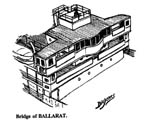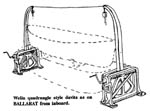Early in this century the P&O line was very interested in obtaining a share
of the England-Australia traffic via the Cape of Good Hope. Several vessels
had been diverted from the traditional Suez routes but the efforts were erratic,
piecemeal and were doomed to failure. In 1910 an opportunity was presented
to enter this trade with more prospects of success. One of the established
traders, the Lund Blue Anchor Line suffered a tragedy. The Waratah,
their newest and largest steamer disappeared without trace on the outbound
voyage from Australia. The Lund family lost interest in ship owning and began
looking for a buyer. The operation ideally suited P&O's needs. The remaining
Blue Anchor fleet was purchased and re-named the P&O Branch Service.
The fleet inherited by P&O was old and run-down and could not effectively
compete with White Star and the Aberdeen Line services. P&O decided to construct
five new ships, the first, Ballarat (2) was delivered in 1911, all
by 1914. The ships offered a one class service and quickly became highly competitive.
In 1914 the British government did not consider the service via the Cape of
Good Hope to be essential, thus the Branch Service ships could be requisitioned
for war service. The class saw extensive service in WWI. Ballarat was
torpedoed and sunk in 1917. Berrima was also torpedoed but was beached
and subsequently repaired. In the early post-war years P&O decided to upgrade
the Branch Service fleet again and ordered five new ships, two delivered in
1921 and the other three in 1923. Ballarat (3), the subject of this
plan, was the first of this new class.
All five ships were externally identical in appearance although there were
small differences and the tonnages varied slightly. Ballarat was built
by Harland & Wolff, Greenock, Scotland. Power was by Triple expansion steam
with twin screws. Her maximum speed was 13.5 knots and she carried 490 third
class passengers (alternately 700 in steerage but not done in practice). Third
class, also called "cabin" class, was a reasonable level of comfort, not the
palatial levels seen on the crack mail liners, but acceptable. This type of
vessel was termed "Intermediate" or "mixed" with equal space devoted
to passengers and to cargo. Dimensions were L.537' (OA) x W.64.3'(molded).
Unfortunately P&O's optimism was misplaced. The downturn in passenger traffic
in the 1920's forced Aberdeen, White Star and the Blue Funnel Line to combine
in offering joint services. P&O found it difficult to compete. They carried
on at a loss until late 1929 when all five vessels were diverted to the Suez
routes. The result was a surplus of tonnage and the Ballarat went to
the ship breakers in 1935 after only 13 years of service. By the end of 1936
all five had been scrapped. Three years later all were probably sorely missed
as they would have made good troop carriers. Economic hard times had blighted
their potential futures.
COLORS: Hull, black with a thin white band the sheer line half way between
the two rows of port holes. Red waterline.
Upper works, Brown, (mid-stone color), including ventilators, kingposts, booms
and life boats. Life boats had dark brown canvas covers. Ventilator mouths
were red. Funnel and masts were black.
Steel decks were dark gray. Wood decks were unpainted.
1/700 Scale Drawings


